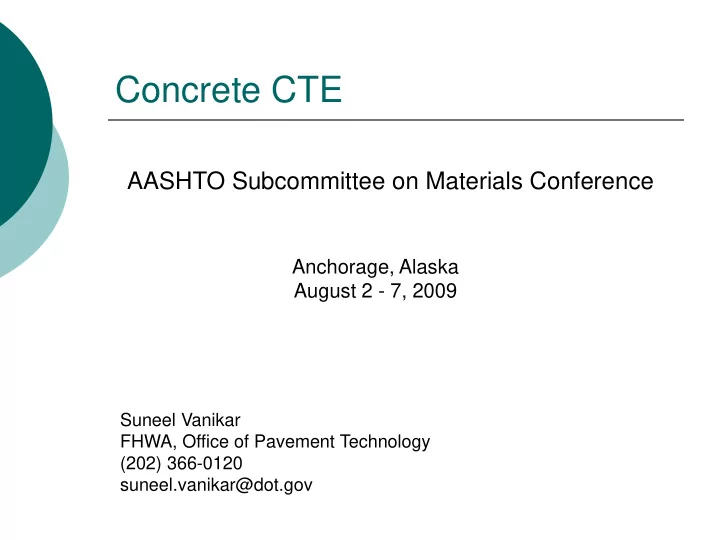

Concrete CTE AASHTO Subcommittee on Materials Conference Anchorage, Alaska August 2 - 7, 2009 Suneel Vanikar FHWA, Office of Pavement Technology (202) 366-0120 suneel.vanikar@dot.gov
CTE Impact on Pavement Performance Early-age cracking (high CTE vs high slab restraint) Transverse/ longitudinal cracking due to curling stresses Faulting (built-in curl, joint opening, curl) Joint spalling (excessive jt movement with high CTE) Crack spacing/ width for CRCP (LTE and punchout) Edge punchouts (due to curl)
CTE =length change/ unit length/ degree 122°F 50°F 0.0059
CTE =length change/ unit length/ degree = 0.0026 in / 7.0 in / 72 F = 5.1 microstrain/ F 122°F 50°F 0.0033
Custom Built CTE Device 304 Stainless Steel
AASHTO TP 60-00 Typical frames made from invar or stainless steel Typical calibration bar made from 304 stainless steel per TP 60 recommendations CTE of 304 SS stated as 17.3 x10 -6 / o C in TP 60
Independent Lab Result for 304 SS Avg.CTE(ppm/ o C) Specimen ID (50 o to 10 o C) Alumina bisque 5.4+/-0.1 304 Stainless Steel - Gilson reference bar 16.2+/-0.1 Titanium 8.9+/-0.1 304 Stainless Standard - Pine reference bar 15.9+/-0.1 410 Stainless Steel 10.4+/-0.1 304 Stainless Steel – TFHRC manual unit 15.8+/-0.1 Precision Materials and Instruments Corporation
Impact of Revised CTE Values LTPP Database AASHTO TP 60 Test Method MEPDG Models in version 1.0 Testing Results from Other Labs
Standard Method of Test for Coefficient of Thermal Expansion of Hydraulic Cement Concrete AASHTO Designation: T 336-09 Section X2.1 The test procedure described in Section 7.2 is used to determine a correction factor to account for expansion of the measuring apparatus during the test. A calibration specimen with a known coefficient of thermal expansion should be used . The specimen should be composed of a material that is essentially linearly elastic , noncorroding, non-oxidizing, non porous and nonmagnetic, and it should have a known thermal coefficient as close as possible to that of concrete e.g. a range of 9 to 18 x10 -6 / o C within the temperature range of 10 to 50 o C (304 stainless steel is a suitable material) An ISO 9001 or equivalent laboratory should determine the CTE of the calibration specimen according to ASTM E 228 or ASTM 289 within the temperature range of 10 to 50 o C and provide a certificate of the CTE value including the lot number of the sample tested. NOTE: When using version 1.0 of the MEPDG software, AASHTO TP 60-00 (2007) should be used.
Effect of CTE on the predicted percent of slabs cracked (6.3 o C) (8.1 o C) (13.5 o C) (15.3 o C) (11.7 o C) (9.9 o C) Effect of CTE variability of Concrete Pavement Performance as predicted using the Mechanistic - Empirical Pavement Design Guide, Jussara Tanesi, M. Emin Kutay, Ala Abbas, and Richard Meininger, Transportation Research Board 2007.
Ongoing/Planned Activities Update LTPP Database (Aug 2009) Update AASHTO 336 (May 2009) Briefings Joint Technical Committee on Pavements (May 2009) DARWin-ME Task Force (June 2009) Recalibrate MEPDG Models (winter 2009) JTCP drafting research problem statement for 20-7 funding (Aug 2009) FHWA Activities Memo to field (Aug 2009) Draft white paper (Aug 2009) CTE inter-lab study- 17 labs (Aug 2009) CTE ruggedness study (summer 2010) Presentations at several TRB concrete/ design committees (Jan 2010)
Recommendations MEPDG version 1.0 use TP 60 CTE values MEPDG version 1.x or version 2.0 use T 336 CTE values Local Calibration Completed – verify after national recalibration of models (version 1.x or 2.0) in process- delay determination of calibration coefficients until national recalibration of models (version 1.x or 2.0) Correction factor to adjust CTE values is difference between assumed and actual CTE of calibration specimen
Summary Current CTE research still valid MEPDG ver 1.0 or ver 1.x - use CTE based on TP 60 (17.3 x10 -6 / C for 304 SS) MEPDG ver 2.0 - use CTE based on new AASHTO Test Method (T 336) and 2009 recalibrated models
Additional Information For additional CTE information contact: Gary Crawford Federal Highway Administration Phone: (202) 366-1286 e-mail: gary.crawford@dot.gov
Recommend
More recommend